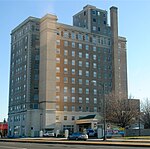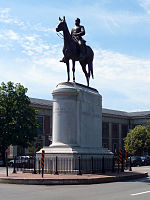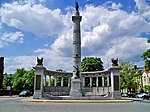Southern Biscuit Company

Southern Biscuit Company, also known as Interbake Foods, Inc. and Famous Foods of Virginia (FFV), is a historic factory building located in Richmond, Virginia. The original section was built in 1927, and is a six-story, reinforced concrete building. It was subsequently expanded four times through 1951. The building features a water tower and distinctive roof-top sign. The sign has three rows of letters spelling "HOME OF", "FFV", and "COOKIES AND CRACKERS". The facility closed in 2006.A 2014 renovation transformed the factory into a 178-unit apartment building. The Cookie Factory Lofts complex covers 240,000 square feet (22,000 m2) and incorporates unique features of the former bakery.The Southern Biscuit Company Building was listed on the National Register of Historic Places in 2012.
Excerpt from the Wikipedia article Southern Biscuit Company (License: CC BY-SA 3.0, Authors, Images).Southern Biscuit Company
Terminal Place, Richmond Scott's Addition
Geographical coordinates (GPS) Address Nearby Places Show on map
Geographical coordinates (GPS)
| Latitude | Longitude |
|---|---|
| N 37.562777777778 ° | E -77.467777777778 ° |
Address
Cookie Factory Lofts
Terminal Place 900
23220 Richmond, Scott's Addition
Virginia, United States
Open on Google Maps








